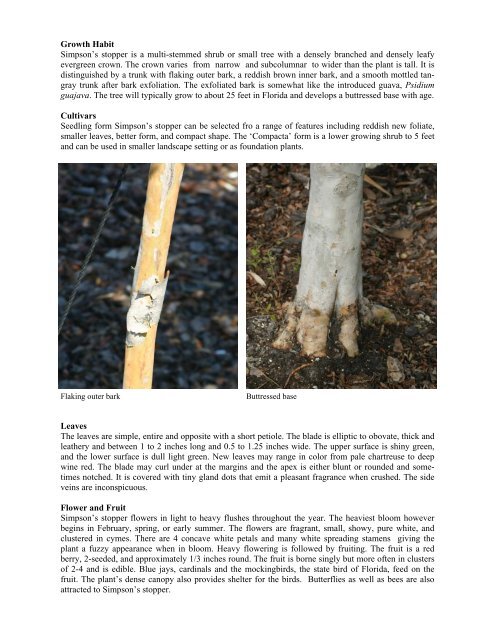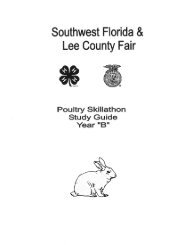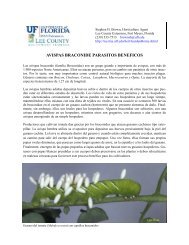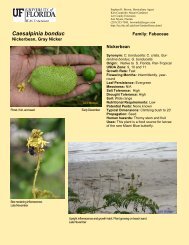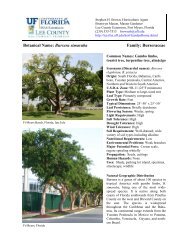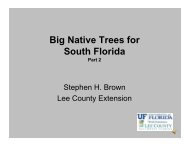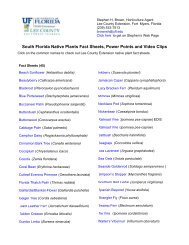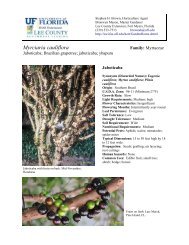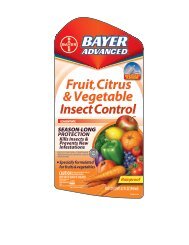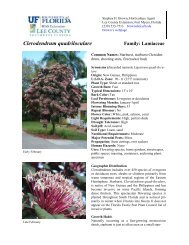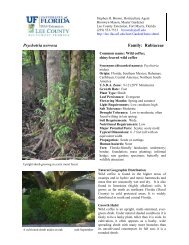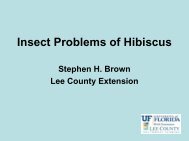Myrcianthes Fragrans Family: Myrtaceae - Lee County Extension ...
Myrcianthes Fragrans Family: Myrtaceae - Lee County Extension ...
Myrcianthes Fragrans Family: Myrtaceae - Lee County Extension ...
Create successful ePaper yourself
Turn your PDF publications into a flip-book with our unique Google optimized e-Paper software.
Growth Habit<br />
Simpson’s stopper is a multi-stemmed shrub or small tree with a densely branched and densely leafy<br />
evergreen crown. The crown varies from narrow and subcolumnar to wider than the plant is tall. It is<br />
distinguished by a trunk with flaking outer bark, a reddish brown inner bark, and a smooth mottled tangray<br />
trunk after bark exfoliation. The exfoliated bark is somewhat like the introduced guava, Psidium<br />
guajava. The tree will typically grow to about 25 feet in Florida and develops a buttressed base with age.<br />
Cultivars<br />
Seedling form Simpson’s stopper can be selected fro a range of features including reddish new foliate,<br />
smaller leaves, better form, and compact shape. The ‘Compacta’ form is a lower growing shrub to 5 feet<br />
and can be used in smaller landscape setting or as foundation plants.<br />
Flaking outer bark Buttressed base<br />
Leaves<br />
The leaves are simple, entire and opposite with a short petiole. The blade is elliptic to obovate, thick and<br />
leathery and between 1 to 2 inches long and 0.5 to 1.25 inches wide. The upper surface is shiny green,<br />
and the lower surface is dull light green. New leaves may range in color from pale chartreuse to deep<br />
wine red. The blade may curl under at the margins and the apex is either blunt or rounded and sometimes<br />
notched. It is covered with tiny gland dots that emit a pleasant fragrance when crushed. The side<br />
veins are inconspicuous.<br />
Flower and Fruit<br />
Simpson’s stopper flowers in light to heavy flushes throughout the year. The heaviest bloom however<br />
begins in February, spring, or early summer. The flowers are fragrant, small, showy, pure white, and<br />
clustered in cymes. There are 4 concave white petals and many white spreading stamens giving the<br />
plant a fuzzy appearance when in bloom. Heavy flowering is followed by fruiting. The fruit is a red<br />
berry, 2-seeded, and approximately 1/3 inches round. The fruit is borne singly but more often in clusters<br />
of 2-4 and is edible. Blue jays, cardinals and the mockingbirds, the state bird of Florida, feed on the<br />
fruit. The plant’s dense canopy also provides shelter for the birds. Butterflies as well as bees are also<br />
attracted to Simpson’s stopper.


